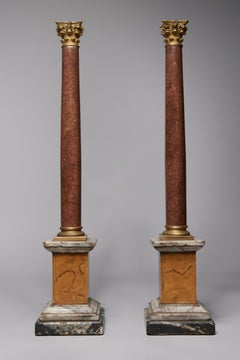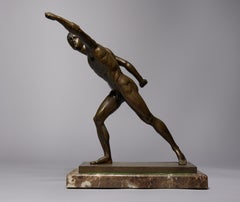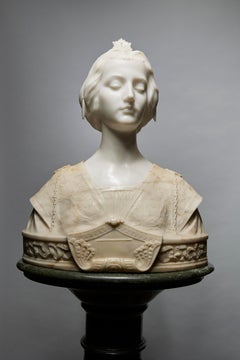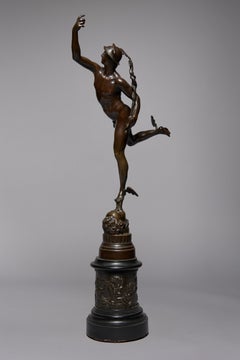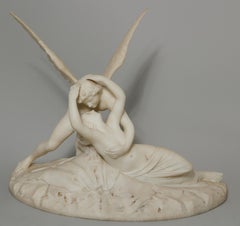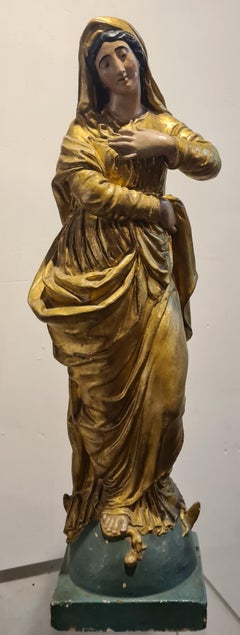19th Century Figurative Sculptures
to
44
212
109
137
67
45
Overall Width
to
Overall Height
to
173
570
2,188
7,451
70
43
105
113
60
122
201
175
218
269
59
6
4
2
2
1
449
325
323
277
266
158
108
69
53
41
34
19
17
16
14
13
11
11
10
10
399
388
128
116
40
27
16
8
7
7
366
203
Period: 19th Century
Pair of Porphyry Marble Columns with Gilt Bronze Capitals, 19th Century
Located in Beachwood, OH
Pair of Porphyry Marble Columns with Gilt Bronze Capitals, 19th Century
Porphyry marble & gilt bronze
20 x 4.25 x 4.25 inches
Porphyry is an igneous rock, not marble, known for its...
Category
19th Century Figurative Sculptures
Materials
Marble, Bronze
19th Century Bronze of the Borghese Gladiator Sculpture
Located in Beachwood, OH
The Borghese Gladiator, 19th Century
Bronze on marble base
Musée du Louvre signed on base
15 x 12 x 8 inches
Since its discovery in the early seventeenth century, the Borghese Gladi...
Category
19th Century Figurative Sculptures
Materials
Marble, Bronze
Late 19th Century Italian Finely Finished Bust of Renaissance Lady w/ Pedestal
Located in Beachwood, OH
Italian, Late 19th Century
Finely Finished Bust of Renaissance Lady
White marble, garment in veined buff colored marble on fitted green marble pedestal
Bust: 22 x 18 x 9 inches
Pedes...
Category
19th Century Figurative Sculptures
Materials
Marble
Mercury Standing on the Breath of Zeus, Antique Grand Tour
By Giambologna
Located in Beachwood, OH
After Giambologna (Italian, 1529-1608)
Mercury Standing on the Breath of Zeus
Bronze
27.5 x 14.25 x 5.5 inches
The sculpture depicts Mercury wearing his winged helmet and sandals and holding a caduceus. Created after one of Giambologna's most celebrated sculptures in the Renaissance, Mercury, was designed as part of a fountain for the Villa Medici in Rome.The head on which Mercury steps symbolizes the figure being “exhaled, purified, unburdened.” When the Giambologna sculpture...
Category
19th Century Figurative Sculptures
Materials
Bronze
Psyche Revived by Cupid's Kiss, Large Marble Sculpture after Canova, 19th C.
Located in Beachwood, OH
After Antonio Canova (Italian, 1757-1822)
Psyche Revived by Cupid's Kiss
Marble
24 x 19 x 16 inches
135 lb.
The love affair between Cupid and Psyche is one of the best known classic...
Category
19th Century Figurative Sculptures
Materials
Marble
French Polychrome and Gilded Statue of The Virgin Mary
Located in Cotignac, FR
A polychrome and gilt plaster statue of the Blessed Virgin Mary. The quality of the original gilding and the handling of the folds in the clothing are exceptional.
A wonderful statu...
Category
Renaissance 19th Century Figurative Sculptures
Materials
Gold Leaf
19th Century Grand Tour Bronze of the Uffizi Wrestlers
Located in Beachwood, OH
After Lysippos (Greek, 390 BC-300 BC)
19th Century Grand Tour Bronze of the Uffizi Wrestlers
Bronze
J. Chiurrazi & Fils, Naples
17 x 20 x 12 inches
76 lb.
The Wrestlers is a Roman m...
Category
19th Century Figurative Sculptures
Materials
Bronze
Grand Tour Bronze Figure of Seated Hermes, Early 19th Century After the Antique
Located in Beachwood, OH
Large Figure of Seated Hermes, Grand Tour Bronze, Early 19th Century
19th Century Continental School After the Antique
The large size figure well cast, with brownish green patination...
Category
19th Century Figurative Sculptures
Materials
Marble, Bronze
Antonio Canova Ebe Aprés Ebe White Marble Sculpture 19th Century Italian
Located in Roma, IT
An important grand tour Antonio Canova Ebe (Aprés), carved in white marble by an Italian sculptor artist in the 19th century from a block of white marble.
The work depicts the go...
Category
Other Art Style 19th Century Figurative Sculptures
Materials
Marble
$29,261 Sale Price
30% Off
19th Century Bust of Antinous as Bacchus/Dionysus w/ Gilt Floral Wreath
Located in Beachwood, OH
Bust of Antinous as Bacchus/Dionysus with Gilt Floral Wreath, 19th Century
F. Barbedienne foundry
Gilt bronze
23 x 12 x 14 inches
Antinous, also called Antinoös, was a Greek youth f...
Category
19th Century Figurative Sculptures
Materials
Bronze
19th Century Grand Tour Figure of Sophocles after the Antique, F. Barbidienne
Located in Beachwood, OH
19th Century Grand Tour after the Antique
Figure of Sophocles
Bronze with green patination
Signed F. Barbidienne, Fondeur
25 x 8.5 x 6.5 inches
Standing figure of the Greek poet, we...
Category
19th Century Figurative Sculptures
Materials
Bronze
Polychrome Marble Sculpture Portrait Emperor Marcus Aurelius Italian 19th
Located in Roma, IT
A portrait head of the Roman Emperor Marcus Aurelius, carved in Carrara marble, with deeply cut curls and detailed classical roman accents in the hair and in the shave; the carefull...
Category
Other Art Style 19th Century Figurative Sculptures
Materials
Marble
$7,136 Sale Price
20% Off
Late 19th Century Bronze Bust of Napoleon Sculpture, Italian Artist
Located in Beachwood, OH
Raphaël Nannini (Italian, 1852-1925)
Napoleon Bust, Late 19th Century
Bronze on marble base
Signed on back
17 x 11 x 8 inches
Raphael Nannini was born in Florence. He exhibited at t...
Category
19th Century Figurative Sculptures
Materials
Marble, Bronze
Cheval Libre (Free Horse)
Located in San Francisco, CA
Artist: After Pierre Jules Mene (French, 1810-1879)
Title: Cheval Libre (Free Horse)
Year: 1868
Medium: Cast bronze sculpture with dark brown patina
Edition: Unknown
Size: Inclu...
Category
Realist 19th Century Figurative Sculptures
Materials
Bronze
Antique Bronze Dog "Whippet with a Butterfly" Arthur Waagen (1833-1898) 1 of 2
Located in SANTA FE, NM
Antique Bronze Dog Portrait
“La Levrette au Papillon” or “Whippet (Greyhound) with a Butterfly”
Arthur Waagen (Germany, France 1833-1898)
Circa 1860’s
11 x 8 x 4 inches
(1 of 2. ...
Category
Academic 19th Century Figurative Sculptures
Materials
Bronze
Large Neoclassical White Marble Sculpture Venus Italica mid-19th century
Located in Pistoia, IT
Venus Italica, imposing sculpture in white Carrara marble, mid-nineteenth-century Roman atelier.
Antonio Canova made several sculptures depicting Venus. The first was made as compen...
Category
Italian School 19th Century Figurative Sculptures
Materials
Marble
Antique Horse Bronze Trotting Stallion Isidore Jules Bonheur (France, 1827-1901)
Located in SANTA FE, NM
Antique Horse Bronze
Portrait of a Trotting Stallion
Isidore Jules Bonheur (France, 1827-1901)
Cast bronze mounted on a rectangular plinth with dark brown patina,
Signed: I. BONHEUR
17 x 11 3/4
A brilliant exploration of a stallion in full trot. The patina is a deep, warm walnut brown with honey-colored tones.
Isidore Bonheur was best known and the most distinguished of the 19th century French animalier sculptors. Isidore, the younger brother of Rosa Bonheur and older brother of Auguste, began his studies of painting initially with his father, who was friends with Francisco Goya. By 1848 he debuted at the Paris Salon having discontinued animal and landscape painting to concentrate on creating sculptures and in 1849, Bonheur enrolled at the Ecole des Beaux Arts. He won medals at the Paris Salon in 1859 and did so again in 1865 and in 1869. After entering the Exposition Universelle 1855, he won the Gold Medal in 1889. In the 1870s exhibited in the London at the Royal Academy of Arts where he earned great prestige and won the coveted Medaille d’Or. After winning numerous other medals and prizes, Bonheur was awarded the Legion d' Honneur in 1895 and he was Knighted in Portugal, Spain and France. Bonheur continued exhibiting at the Paris Salon until 1899.
Many of his bronzes were fabricated at the foundry owned by Hippolyte Peyrol, Bonheur's brother-in-law by marriage to Isidore’s youngest sister Juliette Bonheur. The Peyrol casts for both Rosa and Isidore are exceptionally well executed which suggests a strong working relationship between the founder and sculptor. There is little doubt that Isidore Bonheur was an acute observer of nature; his animals were not anthropomorphized but modelled to catch movement or posture characteristics of the particular species he was sculpting. He achieved this most successfully with his sculptures of horses which are usually depicted as relaxed rather than spirited. These figures are among his most renowned works and his equestrian models became very popular, particularly among the British aristocracy.
An acute observer of nature, his sculptures reflect his commitment to the Realist school - with precise detailing of the movements of animals in their natural habitats. Ultimately, His naturalistic studies of animals are now some of the most highly sought after works by any of the animalier. He was possibly inspired by his many visits to the Buffalo Bill Wild West Show...
Category
Realist 19th Century Figurative Sculptures
Materials
Bronze
Couple Proposing, Baroque Porcelain Clock by Richard Klemm
Located in Long Island City, NY
Richard Klemm, German (1852 - 1916) - Couple Proposing, Medium: Porcelain Clock, maker's mark stamp verso, Size: 39 x 12 x 6.5 in. (99.06 x 30.48 x 16.51 cm)
Category
Baroque 19th Century Figurative Sculptures
Materials
Porcelain
Swan Baby, 19th Century Bronze & Marble Sculpture of Cherub Riding Swan
Located in Beachwood, OH
Auguste Moreau (French, 1834-1917)
Swan Baby, 19th Century
Bronze with reddish gold patination mounted on verdigris marble base
Signed on base
6 x 9.5 x 5 inches
Auguste Moreau was...
Category
19th Century Figurative Sculptures
Materials
Marble, Bronze
Antique French 19th Bronze Equestrian Group Horses Jockeys Statue Sculpture 1895
Located in Portland, OR
A fine late 19th century antique French bronze sculpture group, of a pair of race horses & jockeys, by Paul Louis Emile Loiseau-Rousseau, Paris (1861-1927).
The bronze circa 1895 de...
Category
French School 19th Century Figurative Sculptures
Materials
Bronze
Antique Bronze Dog "Whippet with a Butterfly" Arthur Waagen (1833-1898) 2 of 2
Located in SANTA FE, NM
Antique Bronze Dog Portrait
“La Levrette au Papillon” or “Whippet (Greyhound) with a Butterfly”
Arthur Waagen (Germany, France 1833-1898)
Circa 1860’s
11 x 8 x 4 inches
(2of 2. No...
Category
Academic 19th Century Figurative Sculptures
Materials
Bronze
Horse Playing with a Dog (The Good Companions) Pierre-Jules Mene (1810-1879)
Located in SANTA FE, NM
Antique Horse Bronze
"Horse in the Stable Playing with a Dog (The Good Companions)"
Jument à l'écurie jouant avec un chien
Pierre-Jules Mene (French, 1810-1879)
Bronze
19 x 10 inc...
Category
Realist 19th Century Figurative Sculptures
Materials
Bronze
Antique Silvered Bronze Rooster, France circa 19th Century
Located in SANTA FE, NM
Antique Silvered Bronze Rooster
France, circa 1900
10 1/4 x 9 1/2 (H x D) inches
A very fine and lively bronze statuette of a preening Rooster. Nicely cast and well-carved and in ex...
Category
French School 19th Century Figurative Sculptures
Materials
Silver, Bronze
Frine (Phryne), 19th Century Large Marble Sculpture of Nude Woman
Located in Beachwood, OH
Ercole Rosa (Italian, 1846 - 1893)
Frine (Phryne)
Marble
Signed 'E. Rosa, Studio O. Andreoni, Roma' on back
34.5 x 12 x 10 inches
80 lb.
Phryne was a 4th century BC famous Greek ...
Category
Italian School 19th Century Figurative Sculptures
Materials
Marble
Pair of English Regency Blue John (Derbyshire Spar) Urns, 19th Century
Located in Beachwood, OH
Pair of English Regency Blue John (Derbyshire Spar) Urns, 19th Century
9.5 x 3 x 3 inches
Obtained from the Derbyshire England, Blue John is a semi-precious mineral, a rare form of ...
Category
19th Century Figurative Sculptures
Materials
Marble
Figure of Crouching Venus/Naked Aphrodite, 19th Century Italian School Sculpture
Located in Beachwood, OH
Bronze Figure of Crouching Venus, or The Naked Aphrodite, 19th Century Italian School
Bronze raised on a marble base
21 in. h. x 10 in. w. x 7 in. d., overall
18 in. h. x 8.5 in. w....
Category
19th Century Figurative Sculptures
Materials
Marble, Bronze
Il Bernini - Sculpture by Ambrogio Borghi - 1884
Located in Roma, IT
The bronze proposed here was initially presented in November 1878 at the Competition for the Encouragement of Brera. It is therefore one of the first celebratory works of the sculptor Ambrogio Borghi...
Category
Modern 19th Century Figurative Sculptures
Materials
Bronze
Satyr with Cymbals and Kroupezion, Grand Tour after the Antique, 19th century
Located in Beachwood, OH
19TH CENTURY CONTINENTAL SCHOOL
Satyr with Cymbals and Kroupezion, Grand Tour after the Antique
Bronze with marble base
26 in. h. x 15 in. w. x 10 in. d.
This dancing faun is now mo...
Category
19th Century Figurative Sculptures
Materials
Marble, Bronze
Inspiration
Located in Los Angeles, CA
Beautiful Art Nouveau marble.
Campagne, Pierre Étienne Daniel French , 19th century , male. Active in Paris. Born 1851 , in Gontaud (Lot-et-Garonne). S...
Category
Art Nouveau 19th Century Figurative Sculptures
Materials
Marble
Dancer, bronze, 40x46x12 cm
By Ferdinand Preiss
Located in Riga, LV
Ferdinand Preiss(1882-1943)
Category
Realist 19th Century Figurative Sculptures
Materials
Marble, Bronze
$2,664 Sale Price
20% Off
Bronze French Bulldog by Rembrandt Bugatti(1884 - 1916)
Located in Gent, VOV
Bronze French bulldog
In 1905, Rembrandt Bugatti took his mother's French Bulldog as a model and created this living sculpture, the dog bending its head and seeming to question the ...
Category
Naturalistic 19th Century Figurative Sculptures
Materials
Bronze
The Blacksmith of Solingen / - The Double-edged Sword -
Located in Berlin, DE
Wilhelm Albermann (1835 Werden an der Ruhr - 1913 Cologne), The Blacksmith of Solingen, after 1895. Bronze-color patinated zinc cast on plinth, 47 cm (height) x 20 cm (width) x 16 cm (depth), weight 5.5 kg. Signed “Albermann.” on the plinth and identified as a cast by “AKT.[TIEN] GES.[ELLSCHAFT] GLADENBECK BERLIN”. Dedication on the front: “Mr. Ing. F. Kuhlmann to the wedding. Management and officials of the Hannoversche Waggonfabrik. Aircraft construction department".
- The zinc showing through in spots, the patina somewhat stained, the right upper arm under the sleeve retouched in black.
- The Double-edged Sword -
The figure is a reduction of Wilhelm Albermann's 1895 fountain figure of the armourer of Solingen, who has always been identified with the historical blacksmith Peter Hahn. In 1839, Karl Simrock wrote the poem “The Blacksmith of Solingen" and thus coined the legendary figure. The first and penultimate verses read:
A blacksmith spoke to Solingen
With every bayonet,
That came to his diligence:
"Oh, that Fritz had it!"
The war took its course,
Many battles were fought,
Which often made him fearful and anxious
In his soul.
The blacksmith had given up his trade to fight for Frederick the Great. Not least because of his strength and will to fight, the battles were won. With his fountain sculpture, Albermann has given the legendary blacksmith a figurative form and at the same time created a landmark for the city of Solingen, which was once famous for the art of sword forging and today still stands for the production of high-quality knives. During the bombing raid in November 1944, the fountain was destroyed along with the entire old town of Solingen. Only the head remained.
The broad-shouldered blacksmith stands securely behind his anvil, his leather apron tied around him, and has just finished a sword blade with his own "weapon" - the blacksmith's hammer. His entire body shows the strength with which he wields the hammer, but also the strain of this activity, as evidenced by the wide open shirt, the somewhat 'untidy' apron, and especially the furrowed face.
However, the blacksmith does not look at the finished work, but resolutely and at the same time thoughtfully into the distance, in line with the quoted verse from Simrock's poem that the battles "often made him fearful and anxious in his soul". There is certainly something melancholy in his gaze, fed by the knowledge of the necessity of forging swords and taking up arms and their deadly use - experiences Albermann had to make during his own war missions. The flowing full beard gives his gaze into the distance an almost prophetic character.
In keeping with the craft of the perfectly formed art of blacksmithing, the detailed casting reproduces the respective materials depicted in perfect form: the leather apron convincingly conveys the impression of leather and lies - also in the back view - like a second formed layer over the body, while the shirt and trousers illustrate their own textile qualities.
Due to its masterful execution and profound content, the “Blacksmith of Solingen”, which has survived in its cast reproductions, remains Albermann's most famous work to this day.
About the artist
The son of a carpenter, Wilhelm Albermann began an apprenticeship as a joiner, but then followed his artistic calling and trained as a sculptor in Elberfeld. In 1855, at the age of twenty, he was drafted into the army in Berlin, where he served until 1857. Albermann attended the Berlin Art Academy on the side and began regular studies after his service. While still a student, he completed commissioned works for his teachers August Fischer and Hugo Hagen. His first independent commissions followed, enabling him to establish a flourishing sculpture studio in Cologne in 1865. His artistic activities were repeatedly interrupted by military service, and he took part in the German-Danish War in 1864, the war against Austria in 1866, and the Franco-Prussian War in 1870/71. After his last war service, Albermann, already a respected artist, founded a commercial drawing school at the request of the city government, where he taught the modeling class and served as director until 1896. In 1890 he also worked for the "Society for the Promotion of Sculpture in the Rhineland and Westphalia".
Albermann was one of the most prolific sculptors in Cologne in the second half of the 19th century. He created numerous monuments, fountains, tomb sculptures, architectural ornaments, and domestic statues. At its peak, his workshop employed up to thirty sculptors and stonemasons at a time.
GERMAN VERSION
Wilhelm Albermann (1835 Werden an der Ruhr - 1913 Köln), Der Schmied von Solingen, nach 1895. Bronzefarben patinierter Zinkguss auf gegossener Plinthe, 47 cm (Höhe) x 20 cm (Breite) x 16 cm (Tiefe), Gewicht 5,5 kg. Auf der Plinthe mit „Albermann.“ signiert und als Guss der „AKT.[TIEN] GES.[ELLSCHAFT] GLADENBECK BERLIN“ ausgewiesen. Schauseitige Widmung: „Herrn Ing. F. Kuhlmann zur Vermählung. Direktion und Beamte der Hannoverschen Waggonfabrik. Abt. Flugzeugbau“.
- Punktuelles Durchscheinen des Zinks, Patina etwas fleckig, der rechte Oberarm unter dem Ärmel schwarz retuschiert.
- Die Zweischneidigkeit des Schwertes -
Die Figur ist eine Reduktion von Wilhelm Albermanns 1895 geschaffener Brunnenfigur des Waffenschmieds von Solingen, der seit jeher mit dem historischen Schmied Peter Hahn identifiziert wurde. 1839 hatte Karl Simrock das Gedicht „Der Schmied von Solingen“ verfasst und damit die legendäre Figur geprägt. Die erste und die vorletzte Strophe lauten:
Zu Solingen sprach ein Schmied
Bei jedem Bajonette,
Das seinem Fleiß geriet:
»Ach, daß der Fritz es hätte!«
Der Krieg ging seinen Gang,
Man schlug noch viele Schlachten,
Die oft ihm angst und bang'
In seiner Seele machten.
Der Schmied hatte sein Handwerk ruhen lassen, um selbst für Friedrich den Großen zu kämpfen. Nicht zuletzt durch seine Kraft und seinen Kampfeswillen verliefen die Schlachten siegreich. Dem legendären Schmied verlieht Albermann mit seiner Brunnenskulptur eine bildliche Gestalt und schuf damit zugleich ein Wahrzeichen der Stadt Solingen, die einst für die Kunst des Schwerterschmiedens berühmt war und bis heute für die Herstellung qualitätvoller Messer einsteht. Beim Bombenangriff im November 1944 wurde mit der gesamten Solinger Altstadt auch der Brunnen zerstört. Einzig der Kopf blieb erhalten.
Mit sicherem Stand und umgebundener Lederschürze steht der breitschultrige Schmied hinter seinem Amboss und hat gerade mit seiner eigenen ‚Waffe‘ – dem Schmiedehammer – eine Schwertklinge fertiggestellt. Seinem gesamten Körper ist die Kraft abzulesen, mit der er den Hammer führt, aber auch die Anstrengung dieser Tätigkeit, wovon das weit geöffnete Hemd, die etwas ‚unordentlich‘ arrangierte Schürze und vor allem das zerfurchte Gesicht zeugen.
Der Schmied schaut aber nicht auf das vollendete Werk, sondern entschlossen und zugleich sinnierend in die Ferne, entsprechend der zitierten Zeile von Simrocks Gedicht, dass die Schlachten „oft ihm angst und bang‘ in seiner Seele machten“. Der Blick hat durchaus etwas Melancholisches, dass sich aus dem Wissen um die Notwendigkeit, Schwerter zu schmieden und zu den Waffen zu greifen und deren tödlichem Einsatz speist – Erfahrungen, die Albermann bei seinen eigenen Kriegseinsätze machen musste. Der wallende Vollbart verleiht dem in die Ferne schauenden Blick einen beinahe prophetischen Charakter.
Dem Handwerk der formvollendenden Schmiedekunst entsprechend, gibt der detaillierte Guss die jeweils dargestellten Materialien in vollendeter Ausformung wieder: Die Lederschürze vermittelt überzeugend den Eindruck des Leders und liegt – auch in der Rückenansicht – wie eine zweite ausgeformte Schicht über dem Körper, während das Hemd und die Hose...
Category
Realist 19th Century Figurative Sculptures
Materials
Metal
$1,332 Sale Price
20% Off
Pair of Italian "Alabaster Stone Lions" after Antonio Canova; Mid 19th Century
Located in SANTA FE, NM
"Pair Recumbent Stone Lions"
after Antonio Canova (1757-1822)
Italian (possibly Florence)
Mid 19th Century
Alabaster, marble
6 x 9 x 4 inches
This is an exquisite pair of Italian alabaster lions on marble bases based on the monumental lions carved by Antonio Canova (1757-1822), the greatest Italian neoclassical sculptor. Canova sculpted the marble lions for the monumental tomb of Pope Clement XIII in St. Peter’s, Rome in 1792
Canova Lions refers to the pair of copies of lion sculptures by Antonio Canova. When Canova created the sculptures in 1792, he installed them on the tomb of Pope Clement XIII. The marble sculptures are some of the most prominent features in St. Peter's Basilica in Rome. Given the intricacies of creating the original Canova lions, some artists created molds and replicated them. A good example is the pair of lion sculptures...
Category
Italian School 19th Century Figurative Sculptures
Materials
Marble, Alabaster
A Monumental Patinated Bronze Bust of Jesus Christ by Clesinger and Barbedienne
Located in Queens, NY
A Monumental and Truly Exceptional French Patinated Bronze Bust of Jesus Christ, Circa 1858, Signed J. Clesinger, Rome 1858 & F. Barbedienne Fondeur
This monumental and extraordinar...
Category
19th Century Figurative Sculptures
Materials
Bronze
Seated Mercury, or Hermes - God of Speed
Located in New York, NY
This Mercury by Montagne has lovely patina and surface and is a pleasingly different depiction of Winged speed as he is seated! It is an arresting pose and elegant and covers all fa...
Category
Academic 19th Century Figurative Sculptures
Materials
Bronze
Pair Bronze Candlesticks Rancoulet Signature 19th Century France Sculpture
Located in Riva del Garda, IT
Ernest Rancoulet (Bordeaux 1842 - Bordeaux 1905)
Signature on reverse side ‘Rancoulet’
Pair of bronze candlesticks depicting winged cupids ‘Allegory of Autumn and Spring’
Gilt bron...
Category
Impressionist 19th Century Figurative Sculptures
Materials
Bronze
Early 19th century Romantic marble sculpture - Kiss figures
Located in Varmo, IT
White marble sculpture - The Kiss. 19th century.
15 x 20 x h 20 cm including base, 12 x 17 x h 18 cm excluding base.
Entirely in white marble, some small breaks and repairs.
- ...
Category
Romantic 19th Century Figurative Sculptures
Materials
Marble
$2,378 Sale Price
20% Off
Sleeping Ariadne, Large Bronze & Marble Sculpture of Greek Mythology, 19th C.
Located in Beachwood, OH
Pietro Chiapparelli (Italian, 19th Century)
Sleeping Ariadne, c. 1865
Bronze on marble base
Inscribed 'P. Chiapparelli F.I. Roma'
22 x 24 x 10.5 inches
136 lb.
(34 lb. bottom marble,...
Category
19th Century Figurative Sculptures
Materials
Marble, Bronze
19th Century Bronze Bust of Julius Caesar on Stone Base
Located in Beachwood, OH
Bronze Bust of Julius Caesar, 19th Century
Patinated bronze mounted to stone base
Unsigned
11.25 x 4.5 x 4.5 inches
Gaius Julius Caesar was a Roman general and statesman. A member o...
Category
19th Century Figurative Sculptures
Materials
Stone, Bronze
French antique bronze sculpture by Eutrope Bouret
Located in Berlin, DE
This is an outstanding bronze statue of Eutrope Bouret, signed on the base, by the very well-known French artist Eutrope Bouret (1833-1906).
French antique bronze sculpture by Eutro...
Category
Art Nouveau 19th Century Figurative Sculptures
Materials
Bronze
David Slaying Goliath Large Figural Bronze Statue by Antonin Mercie
Located in New York, NY
The base marked "A. Mercie" and "506 F. Barbenienne, Fondeur, Paris" ad "A. Collas" "Reduction Mecanique."
The dazzling David, a prolific subject amongst sculpture artists beginning...
Category
Academic 19th Century Figurative Sculptures
Materials
Bronze
A Monumental French Patinated Bronze Bust of William Shakespeare, after Houdon
Located in Queens, NY
A Monumental French Patinated Bronze Bust of William Shakespeare, after Houdon, by F. Barbedienne Foundry, circa 1870.
Masterfully and realistically sculpted in solid bronze, this b...
Category
19th Century Figurative Sculptures
Materials
Bronze
VALTON Charles. The Griffin Marco. Patinated bronze. Marble base. Signed.
Located in Paris, FR
The Griffin Marco. Patinated bronze. Marble base. Signed and titled.
Charles Valton was a French sculptor known for his works created in the animalier style, a 19th-century movement ...
Category
Realist 19th Century Figurative Sculptures
Materials
Bronze
Grand Tour Bronze Sculpture of Dionysus, 19th Century Italian School
Located in Beachwood, OH
19th Century Italian School
Grand Tour Bronze Sculpture of Dionysus, 19th Century
Bronze with black-green patination
24 x 10 x 10 inches
Dionysus, in Greco-Roman religion, a nature ...
Category
Italian School 19th Century Figurative Sculptures
Materials
Bronze
Alfred Dubucand (1828-1894): Two hunting dogs
Located in Berlin, DE
Dubucand Alfred 1828-1894
Two Hunting Dogs, Bronze on a Marble Base
The Bronze with the monogram 'E.V.' and the number '2958'
Two Hunting Dogs, Group Signed Alfred Dubucand, Fren...
Category
Realist 19th Century Figurative Sculptures
Materials
Bronze
Large Grand Tour Bronze Greco-Roman Uffizi Wrestlers Ferdinand Barbedienne
Located in Rochester, NY
Grand tour circa 1860s bronze of the Wrestlers. Rich fine dark brown patina. Marked "F. Barbedienne Fondeur." The Wrestlers also known as The Two Wrestlers, The Uffizi Wrestlers...
Category
19th Century Figurative Sculptures
Materials
Bronze, Metal
Early 19th century Empire figure bronze sculpture - woman's bust
Located in Varmo, IT
Small bronze ornament - Bust of a woman. Italy, early 19th century.
8 x 8 x h 29 cm, without base h 23 cm.
Made entirely of patinated and gilded bronze. Depicting a female figure i...
Category
Old Masters 19th Century Figurative Sculptures
Materials
Marble, Bronze
$1,433 Sale Price
33% Off
19th Century Bronze Bust of Young Napoleon as Caesar
Located in Beachwood, OH
After Antonio Canova (Italian, 1757-1822)
Bust of Young Napoleon as Caesar, 19th Century
Hallow cast bronze with verdigris patina, attached to rouge...
Category
19th Century Figurative Sculptures
Materials
Marble, Bronze
19th century French Bronze of a naked woman standing up.
Located in Woodbury, CT
Well modeled 19th century French bronze of a standing naked woman.
Signed Cartinet, this piece is a wonderful example of the skill of a Sculptor.
The piece retains all its origina...
Category
Victorian 19th Century Figurative Sculptures
Materials
Bronze
$1,356 Sale Price
20% Off
Rare Patinated Bronze Sculpture of Benjamin Franklin, by A. Carrier-Belleuse
Located in Queens, NY
Albert-Ernest Carrier-Belleuse (France, 1824-1887)
A rare seated bronze statue of Benjamin Franklin holding his walking stick and hat, with a book in his ri...
Category
Academic 19th Century Figurative Sculptures
Materials
Bronze
Equestrian Louis of Orleans
Located in PARIS, FR
Equestrian Louis of Orleans
by Emmanuel FREMIET (1824-1910)
A very fine bronze equestrian group with a gilded patina
Signed " E. Fremiet " on the base
Cast by " F. Barbedienne Fond...
Category
French School 19th Century Figurative Sculptures
Materials
Bronze
Large Orientalist Bust in Marble of Armida French School 19th century Signed
Located in Pistoia, IT
Zacharie Rimbez (active between 19th and 20th centuries). White marble Orientalist bust depicting Armida, second half of the 19th century.
Armida is a Muslim sorceress, a charact...
Category
French School 19th Century Figurative Sculptures
Materials
Marble
Large 19th Century Antique Marble Bust of Apollo of Belvedere
Located in New York, NY
Pietro Bazzanti (1842-1881) specialized in allegorical and genre subjects as well as copies of Antique and Renaissance sculpture. Regarded as one of the most talented sculptors of h...
Category
Academic 19th Century Figurative Sculptures
Materials
Marble
Carrara Marble Double Janus Sculpture
Located in Los Angeles, CA
A spectacular, hand-carved Carrara marble double Janus sculpture.
Note: green marble showing in some detail images is from a pedestal and not...
Category
19th Century Figurative Sculptures
Materials
Marble
Pair of 19th century scagliola sculptures (Italian Neoclassicism) - Roman figure
Located in Varmo, IT
Pair of scagliola sculptures - Roman figures. Italian manufacture, 19th century.
51 x 26 x h 118 cm (left) - 41 x 28 x h 118 cm (right).
Made entirely of scagliola. Depicting two f...
Category
Old Masters 19th Century Figurative Sculptures
Materials
Plaster
$5,708 Sale Price
20% Off
Marble Figure of a Recumbent Lion, 19th Century
Located in Beachwood, OH
Figure of Recumbent Lion, 19th Century
Carved gray veined marble
4.5 x 8 x 4.5 inches
Category
19th Century Figurative Sculptures
Materials
Marble
Pietro Bazzanti, Italian 19th Carved Marble Figure Semi-Nude Young Bather Girl
Located in LA, CA
Pietro Bazzanti - Barzanti (Italian, 1825-1895) "After the Bath" - A very Fine and large carved white Carrara marble figure of a semi-nude young maiden standing by the sea-shore. The smiling and posing young beauty, with bare breasts and back, her right arm juxtaposed over her head, while holding a blanket over her waist with her left hand and standing barefoot by a rocky seawall and wavy shoreline. Signed 'P. Barzanti/Florence' (on reverse) and raised on a cylindrical swiveling carved verde antico solid marble pedestal. circa: Florence, 1880-1890.
Pietro Bazzanti or Barzanti (Italian, 1825-1895) was a 19th Century Italian sculptor born in Florence. Together with his brother, Niccolò Bazzanti (Firenze, 1802-1869) who was also a sculptor, they both worked the sprawling Florentine studio 'Pietro Bazzanti e Figlio' a hugely successful sculpture studio, operated within the family at their gallery on Lungarno Corsini until the mid-twentieth century. The studio was a place where many talented professors and apprentice sculptors specialized in sculpting marble genre scenes and allegorical figures as well as copies of antique and Renaissance sculpture catered to a prominent international clientele which included European and Russian aristocracy, and the Industrial fortunes being made in England and Americas drove considerable export demand. In 1861 the studio was awarded the medal for 'Ercole con cinghiale sulla spalla' (Hercules with boar on shoulder), 'Due Cani' (Two dogs) and 'Cinghiale' (Boar) sculptures at the National Exposition in Florence. In 1874 he exhibits his works in London and in 1876 in Philadelphia.
Bazzanti frequently returned to the subject of 'After the Bath' or 'The Bather' in his works, having carved examples of the bathing Venus after the Antique and in dynamic and dramatic compositions such as the present sculpture. The finely-detailed work relates closely to popular figures produced by Bazzanti’s contemporary, Cesar Lapini, whose La Sopresa depicts a young woman stepping back from approaching waves. The sculptor’s penchant for realism is on full display with the contrasting matte and highly-polished finishes of the gently lapping waves at the figure’s feet, to the jutting rocks and soft skin. Elegant handling of textures is further exemplified in the draped fringe of the cloth. This monumental and Fine work is illustrated in situ at Bazzanti’s studio circa 1900 among other fashionable works of the period.
Notes: Pietro Bazzanti was also known as Pietro Barzanti. There are conflicting dates of Pietro Bazzanti/Barzanti's birth/death year. Some auction houses and art galleries have described 'Pietro Barzanti' as Italian, 1842–1881 and Pietro Bazzanti as Italian, 1825-1895. However, according to Alfonso Panzetta – Nuovo Dizionario degli Scultori Italiani dell’ottocento e del Primo Novecento – 2003 Edition –Page 78, 'Pietro Barzanti' was in fact 'Pietro Bazzanti' one and the same, and it questions his year of his birth/death as "Firenze (?), ?, ?." thus we believe that the Italian, 1825-1895 description is the most plausible.
Literature:
Alfonso Panzetta – Nuovo Dizionario degli Scultori Italiani dell’ottocento e del Primo Novecento – 2003 Edition –Page 78.
Auctions:
Another example of this sculpture, probably also Pietro Bazzanti but almost a foot shorter (Height 44¾ in. (113.5 cm), unsigned and without its pedestal, was sold at Christie's New York, 19th Century Furniture, Sculpture, Works of Art and Ceramics Sale...
Category
Academic 19th Century Figurative Sculptures
Materials
Marble
THE SPRING
Located in Los Angeles, CA
Beautiful La Belle Epoque marble in nive vintage condition.
Mathurin Moreau (1822-1912) was a French sculptor in the academic style. He was born in Dijon, first exhibited in the 1848 Salon, and finally received a medal of honor...
Category
Academic 19th Century Figurative Sculptures
Materials
Marble
$5,700 Sale Price
40% Off
Antique French Egyptian Revival Bronze Bust Sculpture Statue "Queen of Babylon"
Located in Portland, OR
A good antique cast bronze sculpture an Egyptian Revival bust "The Queen of Babylon", by the 19th century French sculptor Paul Auguste Gagne, circa 1875.
This rare & unusual bronze b...
Category
French School 19th Century Figurative Sculptures
Materials
Bronze
A Rare and Important American Marble Sculpture of Thomas Jefferson, Circa 1870
Located in Queens, NY
A Rare and Important American White Marble Sculpture of Thomas Jefferson Holding The Declaration of Independence. Circa 1870, in the Manner of Horatio Stone (1808 –1875).
Inscribed on scroll: 'The Declaration of Independence, It becomes necessary for one people to dissolve the political bands which have connected them with another. etc. etc. T. Jefferson.
The present work is unsigned but is reminiscent of Horatio Stone's life-size marble figure of John Hancock...
Category
19th Century Figurative Sculptures
Materials
Marble
